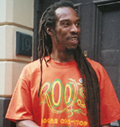The House
'…lately erected by the said Samuel Worrall two brick messuages one fronting to Princes Street (later renamed Princelet Street)... and which said piece of Ground is parcel of a larger piece of Ground in Spittlefields aforesaid… '
Built in 1719 this 'brick messuage' became the home of the Ogier family, who had escaped from persecution in France. They entered the silk weaving trade and prospered mightily.
As most Huguenots moved on, the elegant Georgian houses were sub-divided into lodgings and workshops. At 19 Princelet Street the attic windows were altered to let in more light for weavers to work, but later occupants of the house followed other trades and professions, including Mrs Mary Ellen Hawkins who used it as an industrial school, and Isaiah Woodcock who was a carver and gilder.
'This building - it is quite the most amazing found object..'
Kinsi Abdulleh, artist from Somalia
The Irish came, and later the Jewish emigrants from Eastern Europe. One little group of early arrivals, mostly from Poland, formed the Loyal United Friends Friendly Society to help newcomers, just as the Huguenots had pioneered such self-help groups in the late 17th and 18th centuries. They took a lease on 19 Princelet Street.
In the garden where the Ogier children once played, in 1869 the Jews erected a synagogue. Underneath the synagogue, they created a place where people came together, and - much later - prepared to fight together, against intolerance and fascism.
And 100 years later, up in the third floor attics, in 1969 a recluse, David Rodinsky, locked his door and … disappeared.
'The room is a trap'
Iain Sinclair, warning Rachel Lichtenstein





